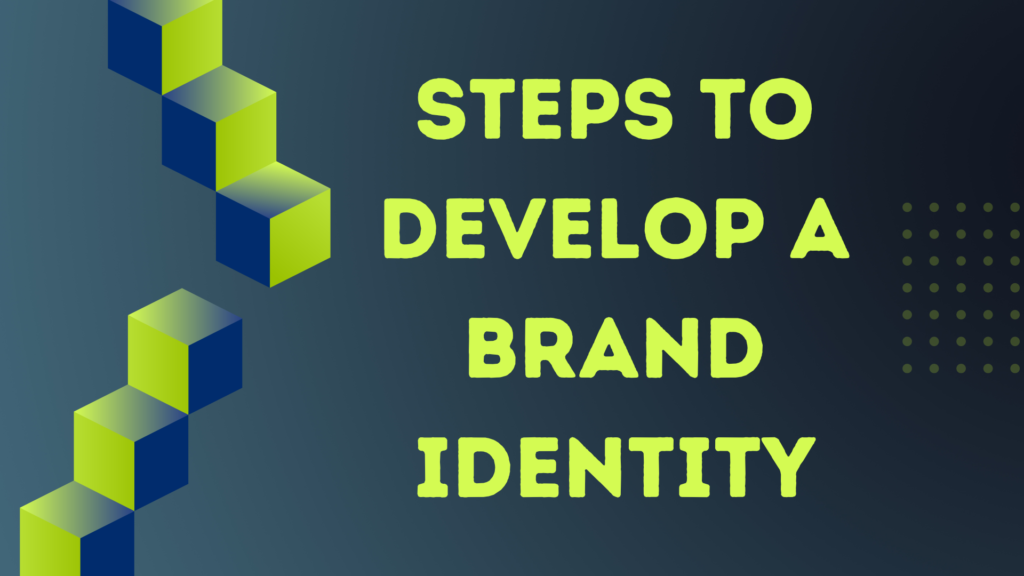Each day millions of businesses are trying to create a brand name for themselves so that they can make a mark in the industry and make a profit. Ideally, as a small business owner, you also aim to have a unique brand that sets you apart from other businesses in your niche. So, the big question is, How can you develop a unique brand identity?
This simple guide will help you develop a brand identity distinct from your competitors.
What is Brand Identity?
Brand Identity is the visual and verbal elements that set businesses apart from their competitors. It encompasses your values, how you communicate business, and the impression you leave on customers after interacting with your product. It includes the following:
- Logo
- Brand name
- Color scheme
- Typography
- Slogan
- Voice and tone of your company
Brand identity also includes design elements that communicate the brand’s values, personality, and purpose. Let’s focus on the steps to developing a unique brand identity.
Steps to Develop a Brand Identity

Here are the steps to follow:
1. Analyze your audience
For you to successfully build a brand identity, understanding your audience is key. You will create a brand that resonates with them and effectively communicates your value proposition.
To analyze your audience, you need to gather data on their
- Demographics
- Psychographics
- Behavior
- Preferences
You can conduct surveys, interviews, focus groups, and market research to understand their needs, challenges, motivations, and buying behavior.
Then, you can tailor your brand identity to appeal to their interests and preferences.
2. Understand what makes your business unique (Value Proposition)
Your value proposition is the selling point that is unique to your brand. Once you have identified your value proposition (specific target audience, a competitive price point, exceptional customer service, etc.), you can use it to create a brand identity that emphasizes this unique selling point. Your brand messaging, visual identity, and marketing materials should all reflect this unique benefit and communicate it clearly to your target audience.
For instance, if you offer high-quality, handmade products, your brand identity (logo, ensign, color palette, and messaging) should emphasize the craftsmanship, attention to detail, and quality of your products.
3. Have a clear mission statement
A clear mission statement is essential in developing a brand identity as it defines your brand’s purpose and values and helps guide your business decisions and actions. A mission statement should be concise, memorable, and reflect your brand’s core values and beliefs. It should articulate the unique value that your brand brings to the world.
4. Create a visual identity
To create a visual identity, design a logo representing your brand. Your logo should be simple, memorable, and versatile to be used across different media and platforms. Your logo can be a combination of text and imagery or a standalone symbol or icon representing your brand.
With a logo out of the way, develop a color palette that reflects your brand’s personality and values. Your visual Identity should be consistent across all your marketing materials. Remember that typography is an essential element of your visual identity. So, ensure you choose fonts that reflect your brand’s personality and are easy to read.
Use other carefully chosen design elements, such as imagery and graphics, to reinforce your brand’s personality and values.
5. Be consistent
All visual and messaging elements representing your brand should be consistent across all platforms and channels. This means you must use it on your website, social media profiles, advertising, and packaging.
When you maintain consistency in your branding efforts, you create a strong and recognizable image that helps your target audience easily identify and connect with your brand.
6. Market your brand
Another effective way to build your brand identity is by sharing valuable, relevant, and engaging content through social media, blog posts, and videos. Your content represents your brand online in every way, and it acts as your virtual storefront, marketing department, and salesperson. So, creating great content that captures your brand’s personality and resonates with your target audience is essential.
7. Monitor and refine your brand identity
Continually evaluate your brand identity’s effectiveness and make adjustments as needed to ensure that it remains relevant and resonates with your target audience. Here are some reasons why monitoring and refining your brand identity is important:
- Changing market conditions: Markets are constantly changing, and consumer preferences, behaviors, and trends evolve over time.
- Brand perception: How your target audience perceives your brand influences their buying decisions, loyalty, and advocacy. Regularly monitoring your brand perception enables you to identify negative perceptions and take corrective action to address them.
- Brand consistency: Monitoring your brand identity ensures that all elements of your brand, including visual identity, messaging, and tone of voice, are consistent across all touchpoints.
- Competitor analysis: This is an effective way to monitor your competitors and their branding strategies. This will help you identify areas where your brand is falling behind or opportunities for differentiation and improvement.
- Refining your brand identity: By monitoring your brand identity, you can update your visual identity, messaging, or tone of voice.
What to Avoid When Building Your Brand Identity

Copying your competitors.
Copying their branding elements, such as color scheme, typography, or tone of voice, can make your brand appear unoriginal and unappealing.
Inconsistency
Inconsistency in branding can confuse your audience and dilute the impact of your messaging. Ensure that all branding elements, including visual identity, messaging, and tone of voice, are consistent across all touchpoints.
Overcomplicating your messaging
When you use cryptic messaging, you will overcomplicate it leading to confusion and disinterest from your audience. So the best communication method should be with a clear and easy message.
Being too generic
Your brand should have a unique personality and stand out from the crowd. Put effort into content creation to keep the interest of your customers. You can snoop at your competitors and find out what kind of content your customers love most. Being too generic in your branding efforts can make your brand appear unappealing and unmemorable.
Neglecting your online presence
Your online presence is essential to building a successful brand identity. Neglecting your online presence will result in missed opportunities to connect with your target audience and grow your brand.
How SwingPointMedia Can Help Develop Brand Identity
Do you know what your brand should be but cannot see it to fruition? At SwingpointMedia, we can help you create content for your website, social media, email marketing, and other digital platforms. We can also help develop your brand identity through brand strategy, visual identity, content creation, website design and development, digital marketing, and brand guidelines. By partnering with SwingPointMedia, you can build a strong and memorable brand identity for your business.
Takeaway
Building a brand identity for your small business will help make it visible and build brand loyalty. Following the steps we have discussed, such as analyzing your market to identify your target audience and their pain points, identifying your value proposition, and capitalizing on that, will help you build a strong brand identity. Remember to market and monitor your brand so that you can adjust where necessary.
SwingPointMedia
Local businesses, especially the ones that are maybe too small to be managed by a marketing company, often struggle to be found by new customers on the internet. SwingPointMedia recognizes this and has created a podcast for local businesses, sharing strategies and tactics that can be applied to help you grow. In addition, SwingPointMedia offers affordable guidance and coaching to local business owners who want or need to “do it themselves” with a goal to reduce and eliminate wasted time and money chasing the wrong “best strategy” for your business.
Want to learn more? Contact us today – Je**@*************ia.com

